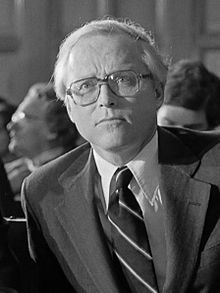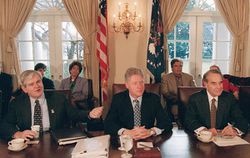What is the history of government shutdowns in the United States
This history of government shutdowns in the United States is relatively recent. In the 19th and early 20th centuries, government shutdowns did not exist, but since 1980 the trend of government shutdowns has not only emerged but has increasingly been as a weapon in US politics. Why has this happened?
Government Shutdowns in the 1980s
The first recorded shutdown occurred on May 1, 1980, during the presidency of Jimmy Carter. The shutdown lasted one day and only affected the Federal Trade Commission (FTC). The critical event that not only created this shutdown but allowed others to emerge later was Benjamin Civiletti's decision (Figure 1), who was the US Attorney General, to interpret that the Antideficiency Act of 1884 indicated that if an agency of the government does not have sufficient funds to continue its required function then that part of government would need to furlough its workers. Initially, it was interpreted that agencies of the US government could continue working without sufficient funds, and fund employees by having the government borrow, and that workers could even be paid until the appropriations could be obtained. Thus, a dispute over the appropriation and oversight of the FTC on the economy in Congress forced the agency to shutdown for one day. Although brief, this produced an important precedent that arguably affected later shutdowns. [1]
Between 1981-1986, three government shutdowns occurred, none of which lasted more than 24 hours. These shutdowns resulted due to Regan's vetos of different appropriations sent to him by Congress. In all of these cases, Ronald Regan had wanted to make more significant cuts to the appropriations of different departments and agencies. The furloughs were shortlived but affected now hundreds of thousands of federal employees. Shutdowns now became a distinct feature of American politics. This was also significant as now appropriations began to increasingly be seen as part of partisan tactics and ideologies. Economists had estimated even these short shutdowns affected the economy in the 10s of millions due to their disruption on the wider economy.[2]
Government Shutdowns in the 1990s
The first shutdown of the 1990s occurred during George H Bush's term from October 6-8th 1990. This shutdown was very minor in that it only affected a few thousand employees, primarily national park and museum employees were affected, with a cost to the economy between $2-3 million. In large part, this was because the shutdown occurred over a holiday period. The main dispute was Bush's desire to increase taxes and make major reductions to Medicare. Eventually, he and Congress compromised by not making large tax increases, with only wealthy individuals seeing their taxes rise, and reductions to government spending proposed were reduced.
The most significant period of government shutdowns occurred between 1995-96, during Bill Clinton's presidency. The first shutdown lasted from November 14-19 1995. At the time, this was the longest shutdown and led to a furloughing of more than 800,000 government employees. Congress under Newt Gingrich's leadership wanted to make large cuts to the federal budget. The second and even more significant shutdown was due to unresolved disputes in the federal budget between Gingrich and Clinton, where this second shutdown lasted from December 16 1995-January 9 1996. This second shutdown was the most significant in terms of its length and arguably politicized shutdowns more than prior shutdowns with both sides having strident comments about the other. For Gingrich, his comments and actions reflected poorly for him in the polls, while Clinton actually his increased popularity and arguably helped him get reelected in 1996. The second shutdown in 1995 led to the furloughing of about 284,000 employees (Figure 2).[3]
One result of the 1995-96 shutdown, and because it was long-lived, was that shutdowns began to be seen as politically costly for the major parties. This effectively meant that both parties tried to avoid shutdowns in the subsequent years after 1996 and this helped to avoid any shutdowns throughout the 2000s and the period of George W. Bush's presidency. However, appropriation disputes often continued and the threat of shutdowns was often used.
More Recent Shutdowns

Since the presidency of Barack Obama, shutdowns have emerged once again as a phenomenon of US politics. In 2013, Congress, this time divided between a Democratic-controlled Senate and a Republican-controlled House, came to major disagreements on the 2014 Continuing Appropriations Bill. Before 2013, shutdowns were often avoided, sometimes at the last minute, using short-term continuing appropriation bills or continuing resolutions (CRs), which effectively allowed government to operate using the previous fiscal year's budget levels. These were short-term solutions that often created uncertainty for government employees but were often resolved because both parties saw shutdowns as too politically costly. However, on October 1, 2013, a 16-day shutdown occurred due to many appropriation disagreements, in particular funding and timing of funding for the 2013 Affordable Care Act being a major source of contention. This bitterness over the new health bill and increased pressure from political groups to try to stop appropriation for this and other funding in the government led to a stalemate in Congress that led to the eventual shutdown. One key source of contention was the debt ceiling that can only be lifted by Congress.
Since the 1990s, the US government spending debt has increased substantially and there was increased concern on expiring debt that would cause the US government to default in its debt obligations. Senate Minority Leader Mitch McConnell (R) and Harry Reid (D), Senate Majority Leader, eventually agreed to lift the debt ceiling and increase income verification in relation to health insurance. Nevertheless, hostility during this time lingered and increased partisanship often made appropriation bills put the government close to shutdown from year to year.[4]
In 2018, the first shutdown of President Trump's tenure occurred on January 20th and lasted to January 23rd. The main dispute revolved around immigration, with Congressional disagreement on funding for the Deferred Action for Childhood Arrivals (DACA) policy, which would prevent the deportation of individuals brought to the United States illegally as minors. Congressional Democrats mostly wanted DACA as official policy, while many Republicans did not. The dispute ended when Republicans agreed to talks on DACA and Democrats removed their filibuster to Republican legislation. The eventual passage of the 2018 Bipartisan Budget Act allowed funding to continue through most of 2018. However, things changed in December 2018.
For the appropriation of 2019, President Trump and some Republicans sought to have funding included in the appropriation for a protective wall along the US-Mexico border. Continuing resolutions that did not include funding for the wall were refused by Trump with Democrats also refusing to include any funding. The lack of compromise created the longest-lived shutdown. From December 22, 2018 to January 25, 2019, the government shutdown affected more than 380,000 through furloughs and 420,000 workers were asked to work without pay. The shutdown mostly came to an end due to increased security and safety concerns due to the record shutdown period affecting the FBI and Transportation Security Administration (TSA), including many unpaid workers calling in sick.[5]
Summary
Shutdowns entered American political discourse, in some ways, perhaps accidentally due to what was, at the time, a relatively minor disagreement about the FTC's role in regulating the economy that led to the Attorney General reinterpreting the 1884 Antideficiency Act to allow for government shutdowns. This decision could be argued has had a great effect on the US government and employees, as it now effectively set a precedent for the politicization of appropriation bills and made shutdowns possible. Whereas before it was not possible to shutdown the government, it became possible for even a minority party in Congress to delay or shutdown the government by demonstrating its disagreement about an issue, sometimes not even directly related to the appropriation in dispute. Shutdowns in 1995-96 had a major impact on US politics by making both parties avoid them for nearly twenty years, but that changed during President Obama's tenure and today's increased partisanship has also led to a more recent record-breaking, at least in time, government shutdown.
Related DailyHistory.org Articles
- What Caused The Economic Panic Of 1837
- Why did Andrew Jackson want to destroy the Bank of the United States
- Why did the United States begin directly electing Senators in 1913
- Why was the Embargo Act of 1807 a failure for President Thomas Jefferson
- What Were the Origins of Ancient Macedon (aka Macedonia)
- What is the history of contested presidential elections in the United States
- What Was the Significance of the Near East Middle Bronze Age System
References
- Jump up ↑ For more on the origins of the 1980 this shutdown had long-term consequences, see: Bacon, D. C., Davidson, R. H., & Keller, M. (Eds.). (1995). The encyclopedia of the United States Congress. New York: Simon & Schuster, pg. 149.
- Jump up ↑ For more on shutdowns during the Regan years, see: Meyers, R. T. (1997). Late Appropriations and Government Shutdowns: Frequency, Causes, Consequences, and Remedies. Public Budgeting & Finance, 17(3), 25–38. https://doi.org/10.1111/1540-5850.01107
- Jump up ↑ For more on the government shutdowns of the 1990s, see: Schier, S. E. (Ed.). (2000). The postmodern presidency: Bill Clinton’s legacy in U.S. politics. Pittsburgh: University of Pittsburgh Press.
- Jump up ↑ For an analysis on the 2013 shutdown, see: Lundy, R. C. (Ed.). (2014). The government shutdown of 2013: perspective and analyses. New York: Nova Publishers.
- Jump up ↑ For more recent politics and government shutdowns, see: Kruse, K. M., & Zelizer, J. E. (2019). Fault lines: a history of the United States since 1974 (First edition). New York: W.W. Norton & Company.

